introduction
The electrical energy-saving design of existing buildings can not be sacrificed at the expense of building functions and damage to the needs of use, nor can it blindly increase investment and save energy for “energy savingâ€. Therefore, the author believes that the principles of electrical energy-saving design should include the selection of transformers, power supply and distribution systems and circuit design, improve system power factor, lighting energy saving, motor energy saving, and selection of power-saving low-voltage electrical appliances. This article will only further explain the lighting energy savings of large-area offices.
1 Lighting Energy Overview
Due to the large amount of architectural lighting, the potential for energy saving in lighting is great. The lighting energy-saving design needs to select the illuminance standard value according to different places, different functional requirements and different standards; select high-efficiency energy-saving light source, lamps and electrical accessories; reasonably select the lighting mode and lighting control mode. Select the lighting power density value in accordance with the national GB50034-2004 "Architectural Lighting Design Standards".
(1) Scientific selection of electric light source
The scientific selection of electric light sources is the primary issue in lighting energy conservation. At present, the luminous efficiency, life and color rendering performance of domestically produced electric light sources are constantly improving, and energy-saving electric light sources are constantly emerging. In terms of the light effect of the light source, the gas discharge light source is higher than the heat radiation electric light source. In the past design, the incandescent lamp that we used to use is a heat radiation source, and the light effect is low, the life is short, and the power consumption is high. Among all kinds of lamps, T8 thin tube fluorescent lamps and compact fluorescent lamps that we are promoting now are 5% higher than ordinary fluorescent lamps, and thin tube fluorescent lamps are 10% more energy efficient than ordinary fluorescent lamps. Because of its high luminous efficiency, fast start-up, and good color rendering, it is mainly used for indoor lighting, except for incandescent lamps in places such as electromagnetic interference and frequent switching. Of course, the use of metal halide lamps in tall spaces is a good choice. Mercury and sodium lamps are used for outdoor lighting, or they can be combined for mixed lighting. This design has high luminous efficiency, low power consumption, realistic light color, coordination and visual comfort. When designing, we must use a suitable light source to meet the requirements of energy saving.
(2) Select high-efficiency lamps
In addition to the need for decoration, high-efficiency lamps with high direct light flux ratio, reasonable light control performance, high reflection or transmission coefficient, and stable light distribution characteristics should be preferred; asymmetric light distribution lamps are used, which have the characteristics of reducing the reflection glare in the working area. Under certain illumination, the visual conditions can be greatly improved, so that higher performance can be obtained; lamps made of materials with slower metamorphism, such as glass lampshades and enamel reflectors, can be used to reduce the rate of light energy decay; The efficiency of the luminaire should not be lower than 70% (not less than 55% when equipped with a blackout grid), and the efficiency of outdoor luminaires should not be lower than 40% (the outdoor floodlight should not be lower than 55%).
(3) Reasonable lighting method
Appropriate use of general lighting, local lighting and hybrid lighting three ways, when a light source can not meet the requirements of illumination, etc., can use two or more sources of mixed lighting, which improves the light efficiency and improves the lighting quality. In the general working area, if the working surface density is not large, local lighting can be installed on the working surface to reduce the waste caused by the large-area increase of lighting fixtures; the high-intensity gas discharge lamp has the characteristics of large luminous flux. The way of lighting, so as to avoid the problem of uneven illumination and glare, and improve the quality of lighting to achieve energy-saving effects.
(4) Reasonable selection of illuminance standard value
When designing lighting, the illumination should be determined according to the needs of work and study. The illuminance value is reasonably determined according to the level of the building and the function of each room; the lighting power density value is determined according to the functional requirements of the lighting place. And should comply with the current national standards "architectural lighting design standards" GB50034-2004.
(5) Reasonable use of lighting control
Make full use of natural light, according to the change of illumination of natural light, the sub-components control the opening and closing of the lamps. Appropriately increase the lighting switch point during design, that is, the number of each switch control luminaire should not be too much for management and energy saving; for the lighting design of large-area places, the partition control mode is adopted, which can increase the flexibility of the lighting branch circuit control. It is beneficial to save electricity when the lighting is not turned on. If there are conditions, the electric lighting can be controlled by dimmers, time switches and power-saving switches. In public places, the lighting can be controlled by centralized control, and the automatic control device with delay can be installed. The rocker switch control can be set on the socket panel. When the electrical equipment is not used, it can easily cut off the power supply of the socket and eliminate the no-load of the equipment. Consumption, to achieve the purpose of saving electricity.
(6) Other lighting energy saving measures
Replace the inductive ballast with an electronic ballast, because the electronic ballast itself has a low power consumption of about 15% of the luminaire efficiency and 95% of the power factor, so it is essential in energy-saving design. . In addition, in the power distribution, try to make the load three-phase balance.
2 Case analysis
2.1 Design principles
When we are designing, we can't blindly pursue high standards of illumination or blindly reduce the value of illumination for energy saving. Both of these consequences are wasteful. Designers should use realistic lighting density values ​​for each building based on the user's perspective and development based on national lighting design specifications. Nowadays, some customary practices in lighting design are often not to use illuminance calculation. Simply use the power density value to calculate the number of lamps required. This method does not exceed the standard for the vast majority of indoor space, but the actual illuminance value. However, it exceeds the illuminance value specified in the standard, which is contrary to the actual energy-saving design principle. To this end, in early 2008, the Beijing Municipal Planning Commission issued the “Beijing Building Energy Efficiency Design Calculation Document Preparation Requirements†(Notification No.: Municipal Regulation [2008] No. 112), which required the illumination of typical rooms to be listed in the construction drawing design. The power density calculation table (see Table 1) is used to regulate the design of lighting energy savings.

2.2 Lighting design calculation and layout
The following is a design example of a typical room to illustrate some of the ideas on how lighting energy can be implemented in electrical design. This room is a large open office in an office building, as shown in Figure 1.
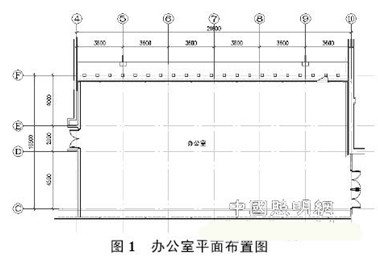
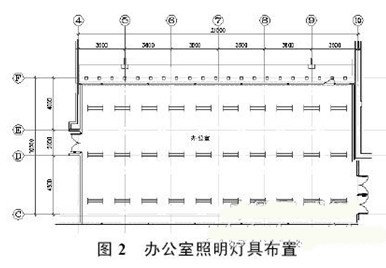
As shown in Figure 1, the office is 21.6m long and 10.5m wide, and the room area is 227m2. According to the "Architectural Lighting Design Standards" 6.1.2, the corresponding illuminance standard value is 300lx, and the standard power density is 11W/m2. The embedded grid fluorescent lamp is used, and the light source adopts T8 tube trichromatic fluorescent lamp. The output lumen of a single light source is 3250 lm, and electronic ballasts (4W each) are used, and the power consumption of each light source is 40W.
If the simple power density value is reversed, a total of 2495W is required, and the number of light sources is required to be 62.4. T8 three-color dual-tube fluorescent lamps are selected. In order to facilitate the room lighting arrangement, 60 light sources are adjusted, and a total of 30 lamps are required. In 3 rows and 10 columns (see Figure 2). The power density value was calculated to be 10.5 W/m2 without exceeding the standard power density value. However, the illumination value calculated based on the number of light sources is 429lx, which is 129lx higher than 43%. The calculation results are shown in Table 2.
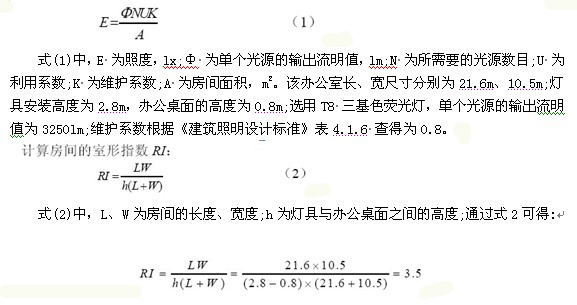
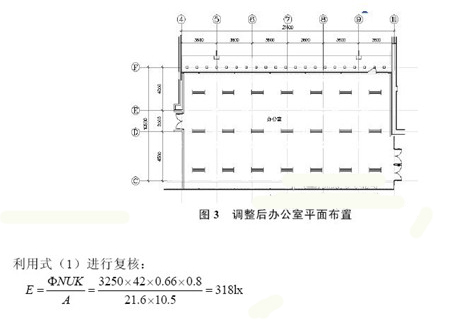
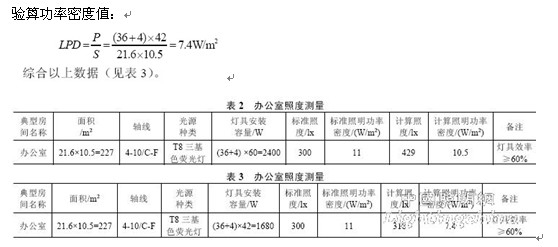
Comparing the calculation results of Table 2 and Table 3, it can be seen that it is not feasible to use the simple power density value to calculate the number of lighting fixtures. The power density value is 10.5W/m2, the illumination value is 429lx, and the power density value is Although the standard illumination power density value is not exceeded, the illuminance value exceeds 43%; the result obtained by the correct calculation method is calculated according to the standard illuminance value, and the power density value is 7.4 W/m2, which is 10.5 W/ The m2 is reduced by 3.1W/m2, and the 227m2 room saves 704W. It can be seen that it is necessary to calculate the illuminance and power density values ​​of representative rooms in the building, and it also has practical significance for building energy conservation.
2.3 Reasonable choice of control methods
After the lighting of the room is reasonable, the lighting control of the lighting is also an indispensable part of lighting energy saving. There are many existing lighting control methods, such as single lamp control, multi-lamp control, and dual control switch control.
In the design of the lighting control mode of this room, the following points should be noted, according to the "Architectural Lighting Design Standards" 7.4: 1 "The number of light sources controlled by the lighting switch should not be too much, the number of switches is not less than 2"; 2 "room cloth There are two or more columns of lamps, and the controlled lamp columns are parallel to the side windows.â€; 3 “When there is natural daylighting, switches are respectively arranged at the near window and the far window.†The above partition control method can be used to increase the lighting branch circuit. The flexibility of control ensures that the place where lighting is not needed does not turn on the light, which is conducive to power saving; make full use of natural light, according to the change of illumination of natural light, control the opening and closing of the lamp according to the component piece; increase the lighting switch point appropriately, that is, each switch The number of lamps to be controlled should not be too large for management and energy saving. As shown in Figure 3, the office has two main personnel entrances and exits on the 4-axis and 10-axis. The office area is large. Therefore, the lighting switch should be set at the entrance and exit of the two personnel in the design. The lights are listed as 3 rows, each of which acts as 7 fixtures. The design should take into account 1 When only a small number of people work, some fixtures can be opened as needed without having to turn on unnecessary lamps to reduce unnecessary energy waste; The office has a south side window at the C-axis and a north side window at the F-axis. When the sunlight is strong during the day, the working area on the side of the south side window can exceed the standard 300lx illumination due to the outdoor sunlight. However, artificial lighting is required in the area on the inner side. In this case, the illumination near the south side window area and the illumination unit on the inner side area can be separately controlled, thereby reducing waste of electric energy and achieving energy saving. At the time of design, the entire employee's office is divided into several independent lighting areas. Since there are two personnel entrances and exits, in order to facilitate the use of personnel, three three-control light switches are installed at the 4-axis personnel entrance and exit, which can be separately controlled. Three to three columns of lamps of 4 to 6 axes; three dual-control lamp switches are provided at the entrance and exit of the 10-axis personnel, and the lamps of three rows and four columns of 7 to 10 axes can be separately controlled. Such a branch control method can also separately control the illumination near the south side window area and the lighting fixture on the inner side area. The control mode of the switch as shown in Fig. 4 can effectively solve the need to illuminate the required lamps when a small number of people work; on sunny days, the staff close to the south side window can close the lamps, effectively Save unnecessary energy.
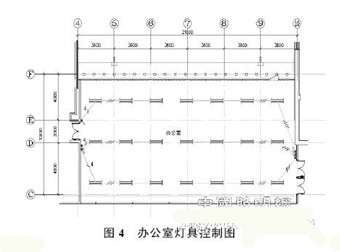
3 Conclusion
With the advancement of society and the development of the economy, lighting is increasingly inseparable from people's lives. China is one of the countries with energy shortages, but energy waste is very serious. Throughout the current situation of China's resources and energy consumption, the implementation of lighting energy-saving technology is not only conducive to the lives of ordinary people, but also to the people, it is more about the country's sustainable development strategy. Therefore, the majority of designers should strive to learn advanced energy-saving technologies, combined with program comparison, priority to adopt economical lighting solutions. Only by careful design and people-oriented, can we achieve the best energy-saving effect and achieve the best economic benefits.
Edit: Nizi
| About Paper Covered Wire. |
Paper Covered Wire includes Nomex Coated Copper Wire, Paper Covered Flat Aluminium Wire, Paper Covered Flat Copper Wire.
Application: oil-immersed transformer windings
Using 100% oxygen free pole as extrusion raw material, insulation material using high density telephone paper, cable paper, polyester, non-woven fabric.Self-locking wrapping is adopted within 6 layers, the bending performance is 15% higher than the national standard, the temperature index is 105℃ after the phone paper and cable paper are impregnated, this product has excellent voltage resistance performance in oil, widely used in transformer coil, stable performance, short processing cycle.

As per Conductor Material:Copper , aluminum
As per Inner Conductor: Paper wrapped bare
Insulation thickness:Double paper covered (DPC) or Triple Paper Covered (TPC) ,According to Customer`s requirements
Paper Covered Wire
Insulated Wire Copper,Paper Covered Wire,Paper Covered Copper Flat Wire,Paper Covered Insulated Wire Copper
HENAN HUAYANG ELECTRICAL TECHNOLOGY GROUP CO.,LTD , https://www.huaonwire.com